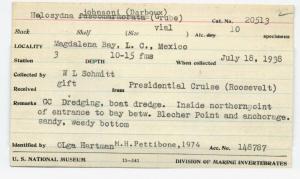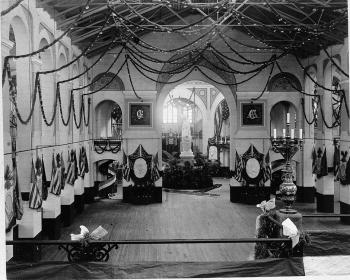The Smithsonian Castle sits just over a mile away from Washington D.C.’s most notable address,1600 Pennsylvania Avenue. We are more than just a short walk away from the White House, however—we are directly tied to it and its occupants. Not only does the Smithsonian collect the history of United States Presidents (including, yes, Lincoln’s top hat and even the hair of a few Founding Fathers), it has historically interacted with the Oval Office. Here’s a look back at the Presidential connections to the Smithsonian—from scientific expeditions, military reconnaissance, to the opening of the National Museum of African American History and Culture.
The Smithsonian was founded in 1846, during eleventh President James K. Polk’s tenure in office. Prior to Polk, other Presidents had still supported the Smithsonian. During his time in office, Andrew Jackson sent a letter to Congress urging them to accept founding donor James Smithson’s bequest. The fledgling Smithsonian’s fiercest supporter, though, was former President John Quincy Adams. Adams served in Congress post-Presidency, and chaired the House Select Committee on the Smithson bequest in 1835. Adams was a strong supporter of science and the arts and saw a value and vision in Smithson’s gift. He described it as “one of the noblest benefactions ever made to the race of man,” and his dogged fight on behalf of the Smithson bequest helped turn the tide of opinion in Congress. Another notable supporter of the Smithsonian, about 100 years later, was Lyndon Baines Johnson, who worked as a school teacher before entering politics.

Several other Presidents were hands-on with the Smithsonian during their terms in office. Abraham Lincoln worked closely with the Smithsonian’s first Secretary Joseph Henry during the Civil War. Henry collaborated with Lincoln in developing war reconnaissance methods for the Union army. He introduced Lincoln to balloonist Thaddeus Lowe, helping the Union develop a balloon corps that could observe enemy troop movement and telegraph locations down to Union soldiers on the ground. Lincoln also worked with Henry to test signal lights—Lincoln with a light in his D.C. summer cottage and Henry with another at the Smithsonian Castle. The Smithsonian, led by Henry, also advised Lincoln on evaluating a variety of scientific proposals for other projects, helping save the Union forces time and money.
 Lincoln was far from the only President who participated in the scientific research side of the Smithsonian. Franklin Delano Roosevelt went on the Presidential Cruise of 1938 to the Galapagos Islands, alongside Waldo L. Schmitt, a curator at the US National Museum (now the National Museum of Natural History). A specimen in the NMNH Department of Invertebrate Zoology collection even has Roosevelt’s name on the label—taken back to the museum on that 1938 expedition. Aside from specimen collecting, FDR influenced the growth of the Smithsonian through his extensive New Deal programs. The National Zoological Park was one of the first institutions to make use of the Works Progress Administration’s federal art programs. Artists were employed to create mosaics and animal sculptures, and even paint the animals’ habitat backgrounds. Workers through other federal programs helped conduct surveys, translate articles, and do maintenance work on Smithsonian buildings.
Lincoln was far from the only President who participated in the scientific research side of the Smithsonian. Franklin Delano Roosevelt went on the Presidential Cruise of 1938 to the Galapagos Islands, alongside Waldo L. Schmitt, a curator at the US National Museum (now the National Museum of Natural History). A specimen in the NMNH Department of Invertebrate Zoology collection even has Roosevelt’s name on the label—taken back to the museum on that 1938 expedition. Aside from specimen collecting, FDR influenced the growth of the Smithsonian through his extensive New Deal programs. The National Zoological Park was one of the first institutions to make use of the Works Progress Administration’s federal art programs. Artists were employed to create mosaics and animal sculptures, and even paint the animals’ habitat backgrounds. Workers through other federal programs helped conduct surveys, translate articles, and do maintenance work on Smithsonian buildings.

![1985 Inaugural Ball: President Ronald Reagan and Mrs. Nancy Reagan Dancing in National Air and Space Museum, 1985, 1985, Smithsonian Institution Archives, SIA Acc. 11-009 [85-725-17]. 1985 Inaugural Ball: President Ronald Reagan and Mrs. Nancy Reagan Dancing in National Air and Space](https://ids.si.edu/ids/iiif/SIA-85-725-17-000002/full/300,/0/default.jpg)
Richard Nixon remains the only President whose Smithsonian inaugural party included a chicken chase. The live chickens were in the museum as part of an exhibit on American farm life and one escaped during the party—flying into the VIP box and upsetting the guests. Luckily, Smithsonian Secretary S. Dillon Ripley, an ornithologist, was in attendance and captured the rogue chicken.
Finally, as Presidents were important in helping establish the Smithsonian itself, it is worth noting how that tradition has continued through present day. The Smithsonian’s newest museum, the National Museum of African American History and Culture, was signed into law by George W. Bush in 2003. Our forty-fourth President Barack Obama helped break ground for NMAAHC in 2012, and formally opened it to the public on September 24, 2016.
Related Resources
Presidential Inaugural Balls at the Smithsonian, Smithsonian Institution Archives
The Presidents, The White House
The American Presidency: A Glorious Burden, National Museum of American History
Produced by the Smithsonian Institution Archives. For copyright questions, please see the Terms of Use.

![Franklin D. Roosevelt aboard ship during the Presidential Cruise, 1938. Smithsonian Institution Archives, Image Number SIA RU007231 [SIA2011-2232]. Franklin D. Roosevelt aboard ship during the Presidential Cruise, 1938.](https://siarchives.si.edu/sites/default/files/styles/body-image-230/public/blog-attached-images/SIA-SIA2011-2232%20%286%29.jpg?itok=6bMOWN6q)

Leave a Comment